A Multi-Step Process of Viral Adaptation to a Mutagenic Nucleoside Analogue by Modulation of Transition Types Leads to Extinction-Escape
Resistance of viruses to mutagenic agents is an important problem for the development of lethal mutagenesis as an antiviral strategy. Previous studies with RNA viruses have documented that resistance to the mutagenic nucleoside analogue ribavirin (1-β-D-ribofuranosyl-1-H-1,2,4-triazole-3-carboxamide) is mediated by amino acid substitutions in the viral polymerase that either increase the general template copying fidelity of the enzyme or decrease the incorporation of ribavirin into RNA. Here we describe experiments that show that replication of the important picornavirus pathogen foot-and-mouth disease virus (FMDV) in the presence of increasing concentrations of ribavirin results in the sequential incorporation of three amino acid substitutions (M296I, P44S and P169S) in the viral polymerase (3D). The main biological effect of these substitutions is to attenuate the consequences of the mutagenic activity of ribavirin —by avoiding the biased repertoire of transition mutations produced by this purine analogue—and to maintain the replicative fitness of the virus which is able to escape extinction by ribavirin. This is achieved through alteration of the pairing behavior of ribavirin-triphosphate (RTP), as evidenced by in vitro polymerization assays with purified mutant 3Ds. Comparison of the three-dimensional structure of wild type and mutant polymerases suggests that the amino acid substitutions alter the position of the template RNA in the entry channel of the enzyme, thereby affecting nucleotide recognition. The results provide evidence of a new mechanism of resistance to a mutagenic nucleoside analogue which allows the virus to maintain a balance among mutation types introduced into progeny genomes during replication under strong mutagenic pressure.
Published in the journal:
. PLoS Pathog 6(8): e32767. doi:10.1371/journal.ppat.1001072
Category:
Research Article
doi:
https://doi.org/10.1371/journal.ppat.1001072
Summary
Resistance of viruses to mutagenic agents is an important problem for the development of lethal mutagenesis as an antiviral strategy. Previous studies with RNA viruses have documented that resistance to the mutagenic nucleoside analogue ribavirin (1-β-D-ribofuranosyl-1-H-1,2,4-triazole-3-carboxamide) is mediated by amino acid substitutions in the viral polymerase that either increase the general template copying fidelity of the enzyme or decrease the incorporation of ribavirin into RNA. Here we describe experiments that show that replication of the important picornavirus pathogen foot-and-mouth disease virus (FMDV) in the presence of increasing concentrations of ribavirin results in the sequential incorporation of three amino acid substitutions (M296I, P44S and P169S) in the viral polymerase (3D). The main biological effect of these substitutions is to attenuate the consequences of the mutagenic activity of ribavirin —by avoiding the biased repertoire of transition mutations produced by this purine analogue—and to maintain the replicative fitness of the virus which is able to escape extinction by ribavirin. This is achieved through alteration of the pairing behavior of ribavirin-triphosphate (RTP), as evidenced by in vitro polymerization assays with purified mutant 3Ds. Comparison of the three-dimensional structure of wild type and mutant polymerases suggests that the amino acid substitutions alter the position of the template RNA in the entry channel of the enzyme, thereby affecting nucleotide recognition. The results provide evidence of a new mechanism of resistance to a mutagenic nucleoside analogue which allows the virus to maintain a balance among mutation types introduced into progeny genomes during replication under strong mutagenic pressure.
Introduction
The biology of RNA viruses is heavily marked by high mutation rates and quasispecies dynamics, relevant not only for virus evolution but also for viral pathogenesis (review in [1]). The adaptive potential of viral populations as they replicate in the infected hosts represents a formidable problem for the control of viral disease by treatment with antiviral agents. Indeed, selection of viral mutants with decreased sensitivity to one or multiple antiviral inhibitors is an almost systematic occurrence, mainly for riboviruses and retroviruses [2]–[7]. The understanding of pathogenic RNA viruses as quasispecies opened the way to the exploration of a new antiviral approach termed virus entry into error catastrophe or lethal mutagenesis. This strategy was inspired in one of the corollaries of quasispecies theory that asserted that for any replicating system there must be a limit to the average error rate during template copying above which the information conveyed by the system cannot be maintained [8]–[13]. Applied to viruses, this concept implies that an increase of the viral mutation rate by mutagenic agents should result in virus extinction. This prediction has been amply confirmed experimentally with several virus-host systems in cell culture and in vivo, using different mutagens, notably nucleoside analogues [14]–[27].
One of the problems for a successful application of lethal mutagenesis to virus extinction is the selection of mutant viruses resistant to mutagenic agents. This problem has been manifested with the selection of picornavirus mutants with decreased sensitivity to the mutagenic base analogue ribavirin (1-β-D-ribofuranosyl-1-H-1,2,4-triazole-3-carboxamide) (R) [27]–[31]. R is a licensed antiviral agent that has been used over several decades to treat some human viral infections, notably hepatitis C virus (HCV) infections, in combination with interferon (IFN) α or IFN α derivatives [32]–[35]. Since the important discovery that R is mutagenic for poliovirus (PV) [36], R has been used as mutagenic agent in experimental studies of lethal mutagenesis of several RNA viruses [21], [27], [36]–[42]. However, R has several mechanisms of action [43], [44] and whether R mutagenesis participates in the elimination of HCV during treatment of chronic HCV infections is still an open question [45]–[49].
Picornaviruses have contributed to the understanding of the molecular basis of resistance to R. A poliovirus (PV) mutant with decreased sensitivity to R included substitution G64S in its RNA-dependent RNA polymerase (termed 3D). This substitution confers resistance to R through a general increase in template copying fidelity, at the cost of producing mutant spectra of lower complexity than wt PV. Limited mutant spectrum complexity resulted in PV populations which were less adaptable to a complex environment, a direct proof of the essential contribution of high mutation rates to RNA virus adaptability [29], [31]. In the case of foot-and-mouth disease virus (FMDV), resistance to R was associated with substitution M296I in 3D. Contrary to substitution G64S in PV, M296I did not result in increased template-copying fidelity of the 3D of FMDV. Rather, the mutant FMDV restricted the incorporation of RTP into RNA through an alteration of residues in the neighborhood of the active site of 3D that did not have a significant effect on the rate of misincorporation of the standard nucleotides [27], [50], [51].
Replacement M296I was sufficient to prevent extinction of FMDV by high concentrations of R, but the virus was extinguished by an alternative mutagenic treatment that included 5-fluorouracil (FU) [52]. Since R-resistance mutations can jeopardize viral extinction by lethal mutagenesis, it is of upmost importance to understand the molecular mechanisms of R-resistance, with the objective of designing adequate protocols for virus extinction. FMDV with replacement M296I was selected upon passage of the virus in the presence of increasing R concentrations in the range of 200 µM to 800 µM included in the cell culture medium [27]. Since R reduces the viability for BHK-21 cells in 40% after two days of treatment [42], [52], [53] (see Materials and Methods), and allowed virus replication, we tested the response of FMDV to replication in the presence of high concentration of R. Here we report that FMDV populations replicated in the presence of concentrations of R in the range of 800 µM to 5000 µM, accumulated two additional amino acid substitutions in 3D in a step-wise fashion. The substituted polymerase displays a new molecular mechanism of R-resistance based on modulation of the types of R-induced misincorporations during RNA synthesis, based on an alteration of the pairing preference of R opposite C and U. In this manner, the mutant FMDV, but not the wild type FMDV, produces progeny RNA that shows a balanced distribution of transition types despite replicating in the presence of R. Studies of polymerization activity by the purified polymerases suggest that a single amino acid substitution in a loop of the fingers domain is the alteration chiefly responsible of the altered mutational pattern. The crystal structures of the substituted polymerases in complex with RNA show a conformational change in the template entry channel of the polymerase, that may affect the binding of the ssRNA template to 3D, mainly at the base of the template which is immediately downstream of the position that receives the incoming nucleotide. Alteration of the position of the template RNA at the active site of the enzyme may affect nucleotide recognition and modify the transition mutation pattern in the presence of R. The findings establish a new mechanism of lethal mutagenesis-escape in viruses which rests on regulation of the mutational spectrum in progeny viral genomes.
Results
Adaptation of FMDV to high ribavirin concentrations
A biological clone of FMDV termed C-S8c1 is the standard virus used in our studies of molecular evolution and lethal mutagenesis of FMDV [54]. FMDV C-S8c1 was serially passaged in BHK-21 cells, and a monoclonal antibody (MAb)-escape mutant termed MARLS was isolated from the population at passage 213 [55]. FMDV MARLS was then subjected to passages in the presence of 200 µM to 800 µM R in the culture medium, resulting in selection of population R-Ap35 which included amino acid substitution M296I in 3D [27] (Figure 1). Population R-Ap35 displayed higher fitness than wild type FMDV in the presence of R but not in its absence [27]. Although M296I was the only replacement that became dominant in FMDV populations passaged in the presence of R (the diagnostic nucleotide band in the consensus sequence did not indicate any detectable amount of an alternative nucleotide), other substitutions in 3D that did not reach dominance were also observed [56]. To study the response of FMDV to replication in the presence of higher concentrations of R, population R-Ap35 was subjected to 10 additional passages in the presence of 800 µM R, and then to 15 passages in the presence of increasing concentration of R (from 1000 to 5000 µM), to obtain population R-Ap60 (Figure 1). Populations R-Ap60 and R-Ap35 displayed a similar mutation frequency in their mutant spectra (Table 1), but the specific infectivity [plaque-forming-units (PFU)/amount of viral RNA] of R-Ap60 was 10-fold lower than that of R-Ap35 (Table 1). These results suggest that virus replication under increased R concentrations led to loss of virus viability, not necessarily correlated with a significant increase of average mutation frequency.
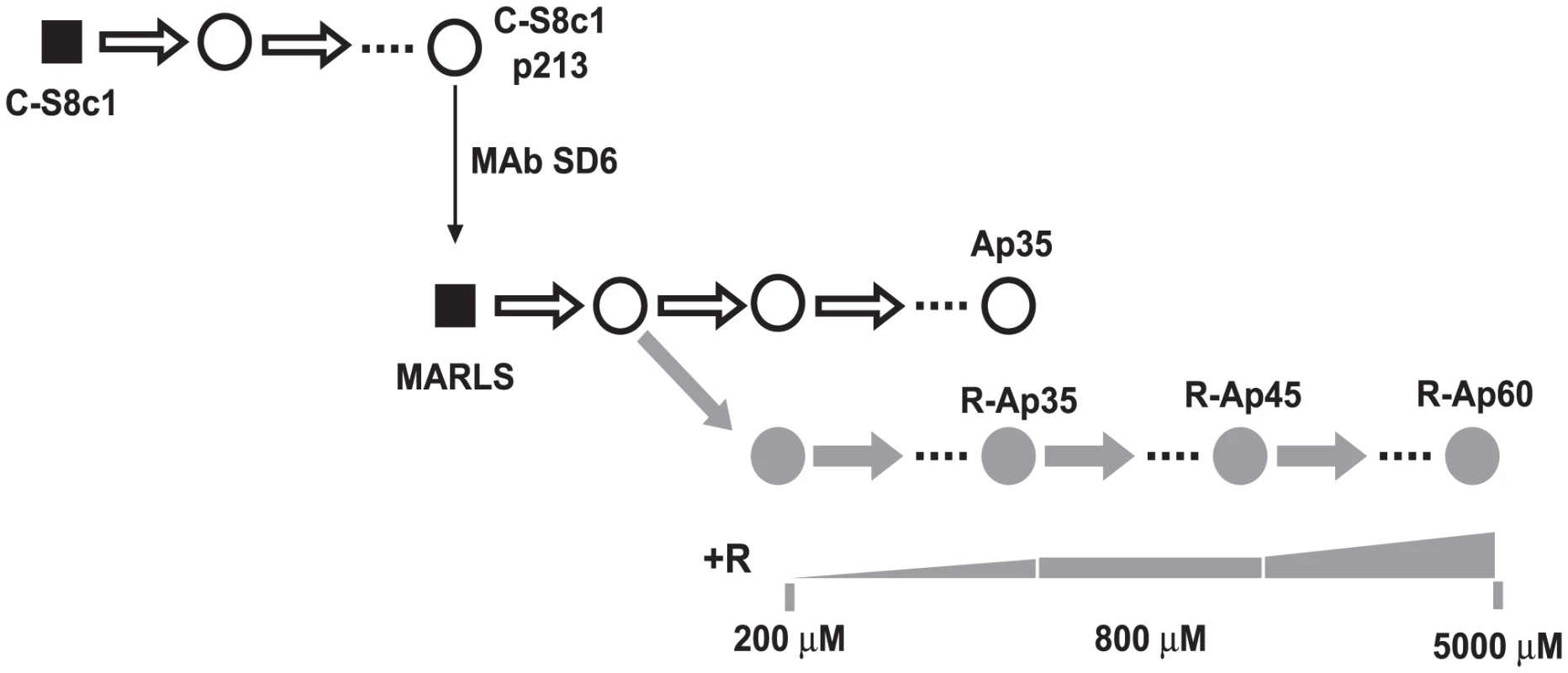

To test whether population of R-Ap60 was better adapted to R than population R-Ap35, the relative fitness of the two populations was determined in growth-competition experiments in the presence and absence of R, using as reference the virus population Ap35 (which is FMDV MARLS passaged 35 times in the absence of R, as described in Materials and Methods and in [27]). The results (Table 2) indicate that R-Ap60 is better adapted than R-Ap35 to replicate in the presence of R. The adaptation of R-Ap60 resulted from a specific response of FMDV to R, since the fitness of R-Ap60 relative to R-Ap35 in the presence of FU and guanidine hydrochloride (GuH) (an alternative mutagenic combination used in lethal mutagenesis of FMDV [52]) was 0.7 (Table 2). Thus, FMDV underwent a progressive adaptation to replicate efficiently under high R concentration.

Adaptation of FMDV to high ribavirin concentrations entails additional substitutions in 3D
To study whether adaptation of FMDV to increased concentrations of R was associated with additional substitutions in 3D, the consensus nucleotide sequence of the 3D-coding region of R-Ap35 and R-Ap60 was analyzed (Table 3). Two new mutations were found as dominant in R-Ap60: C6739U (that gives rise to amino acid substitution P44S in 3D), and C7114U (that gives rise to P169S in 3D). In addition, 3D maintained as dominant substitution M296I which was already dominant in R-Ap35 [27], [50]. P44S but not P169S was detected in a 70% proportion in R-Ap35, as evidenced by analysis of both the consensus sequences and their corresponding mutant spectra (Table 3). These results suggest that the three substitutions in 3D were selected sequentially during replication in the presence of increasing concentrations of R: first M296I, then P44S and finally P169S.
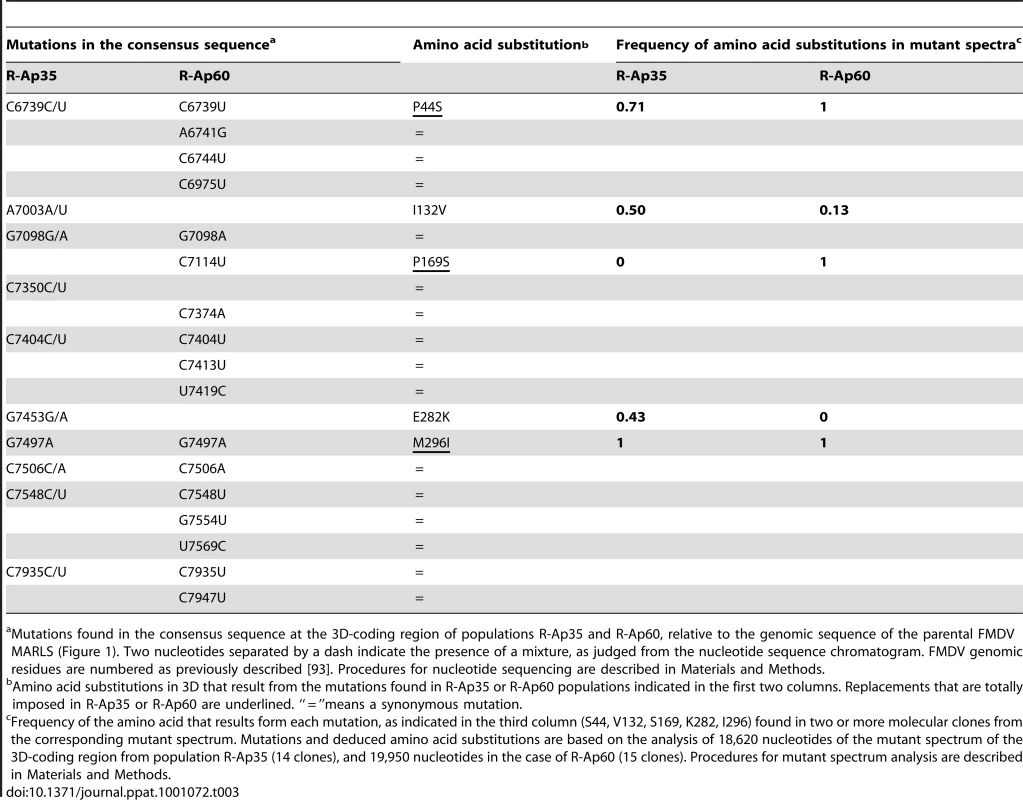
The replacements in 3D increase FMDV fitness in the presence of ribavirin
To investigate the effect of the 3D substitutions in the sequence context of pMT28 (the plasmid from which C-S8c1 is expressed [57]) without possible confounding effects of other mutations in the viral genome, plasmids pMT28-3D(M296I), pMT28-3D(P44S), pMT28-3D(P169S), pMT28-3D(P44S, M296I) and pMT28-3D(SSI) (SSI means the presence of the triple replacement P44S, P169S and M296I in 3D) were constructed as described in Materials and Methods. These plasmids encode the genome of C-S8c1 with the mutations that give rise to the indicated substitutions in 3D, as the only difference with respect to the wild type sequence (pMT28 or C-S8c1 [57]). BHK-21 cells were transfected with the corresponding RNA transcripts and the rescued viruses [termed FMDV 3D(M296I), FMDV 3D(P44S), FMDV 3D(P169S), FMDV 3D(P44S, M296I) and FMDV 3D(SSI), respectively] were tested regarding infectious progeny production (Figure 2). FMDV 3D(M296I), FMDV 3D(P44S, M296I), and FMDV 3D(SSI), but not FMDV 3D(P44S) and FMDV 3D(P169S), showed lower progeny production in the absence of R. Fitness measurements in the absence and presence of R (Table 4) indicate that the triple replacement P44S, P169S and M296I conferred on the virus a selective advantage in the presence of R. The addition of P169S to a virus harboring P44S and M296I provided an advantage during replication in the presence of 5000 µM but not 800 µM R. A direct competition showed a selective advantage of FMDV(SSI) over FMDV 3D(M296I) in the presence of 5000 µM R. P44S and P169S individually did not inflict a fitness cost upon the virus in the absence of R, whereas M296I and the triple combination did (Table 4).
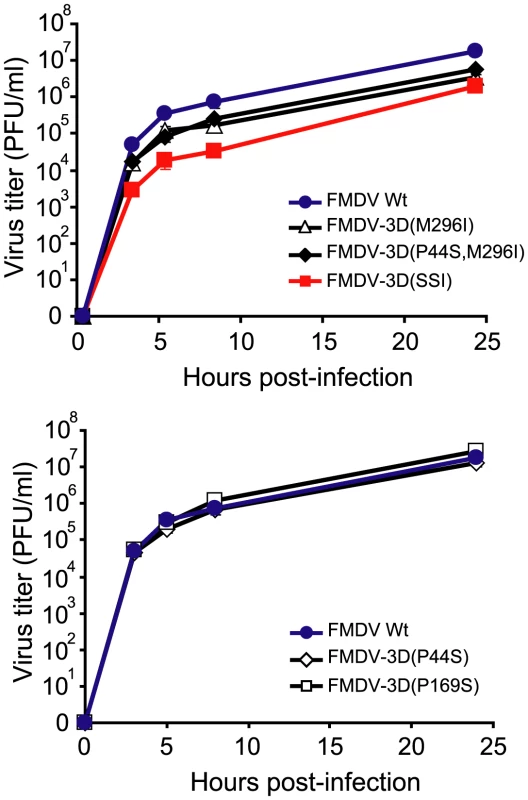
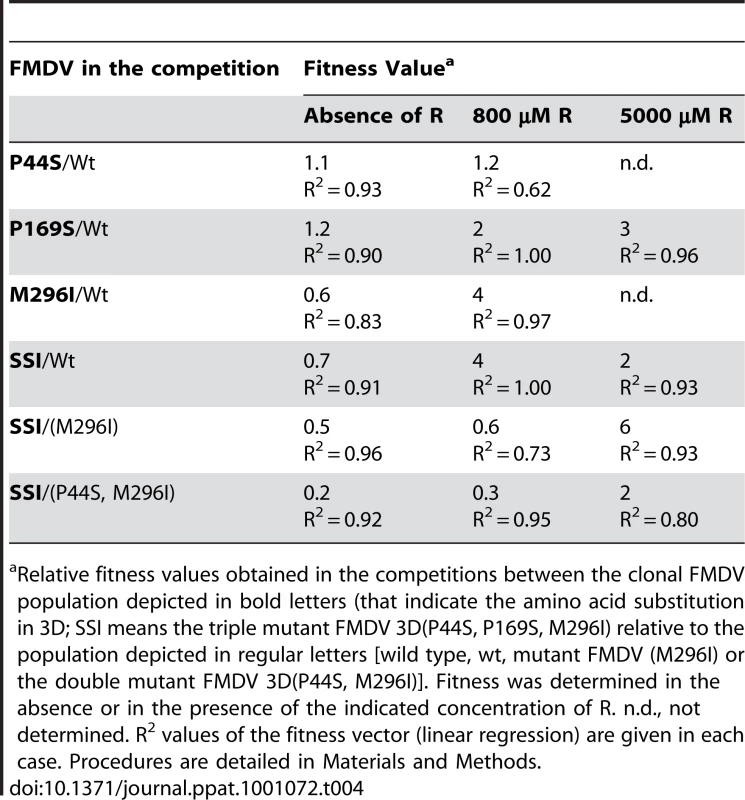
The three dominant substitutions in the polymerase of the clonal FMDV 3D(SSI) failed to reproduce the fitness difference between populations R-Ap60 and R-Ap35 in the presence of R (compare Tables 2 and 4). This means that factors other than the three dominant replacement in 3D must intervene to confer the growth advantage of R-Ap60 in the presence of R (see Discussion). These additional factors are presently under investigation.
The mutant spectrum of pMT28-3D(SSI) passaged in the presence of ribavirin reveals an unexpected repertoire of mutations
The mutant spectra of FMDV populations passaged in the absence of drugs display a balance among the four types of transition mutations with a slight dominance of U→C and A→G versus C→U and G→A [27], [58]–[60]. However, FMDV replication in the presence of R inverted this trend, and resulted in a clear dominance of C→U and G→A transitions [27], [42], as also observed with poliovirus (PV) replicating in the presence of R [21], [36]. It was suggested that the bias in favor of C→U and G→A observed in FMDV could reflect a preference for ribavirin-5′-monophosphate (RMP) to be incorporated by 3D polymerase more efficiently opposite to C than U in the template, but this was not supported by the biochemical data on the incorporation of RMP by purified FMDV 3D using heteropolymeric template-primers [27]. The biased mutation types during intracellular viral replication could be influenced by the decrease in intracellular GTP levels due to the inhibition of inosine monophosphate dehydrogenase (IMPDH) by ribavirin-monophosphate (RMP) [42], [43], [61], although previous studies suggested a minor effect of decreased intracellular concentration of GTP on the mutagenic activity of R on FMDV [42].
To explore possible variations in mutation frequency and in the types of mutations as a result of R treatment, FMDV wild type (Wt) (rescued from plasmid pMT28) and FMDV 3D(SSI) were subjected either to five passages in the absence of R (that gave rise to populations abbreviated as Wt-5 and SSI-5, respectively) or to four passages in the presence of 5000 µM R (that gave rise to populations abbreviated as R-Wt-4 and R-SSI-4, respectively). The comparison of mutation frequencies in the mutant spectrum of the different populations showed a 3.5-fold increase in both viruses after passage in the presence of R, as expected [27], [42], [52], but no significant difference in mutation frequency between Wt-5 and SSI-5 (t = 0.45, P>0.1; t Student's test) or between R-Wt-4 and R-SSI-4 (t = 1.16, P>0.1; t Student's test) was seen (Table 5). The mutant spectra of Wt-5 and SSI-5 showed a similar distribution of mutation types (χ2 = 0.02, P>0.1; χ2 test), with a slight dominance of U→C and A→G, as previously found in FMDV populations that had replicated in the absence of R [27], [58]–[60]. However, the mutation pattern of R-SSI-4 was unexpected for a virus passaged in the presence of a high concentration of R. While in the mutant spectrum of R-Wt-4 the bias in favor of C→U and G→A transitions reached 80%, in R-SSI-4 these transition types amounted to 34% of the total number of mutations. Thus, the repertoire of transition types remained balanced in FMDV 3D(SSI) despite replication in the presence of R, in sharp contrast with FMDV Wt which presented a gross imbalance in favor of C→U and G→A transitions. The ratio (C→U)+(G→A)/(U→C)+(A→G) in the mutant spectra of R-SSI-4 and SSI-5 was virtually identical (χ2 = 0.49, P>0.1) (Table 5). This result indicates a remarkable insensitivity to the presence of R regarding the mutations represented in progeny RNA when replacements P44S, P169S and M296I were present in 3D. The insensitivity to R could not be attributed to the absence of replication of FMDV 3D(SSI) in the presence of R since in fact this virus replicates more efficiently than wild type in the presence of R (Table 4). Thus, R-Wt-4 and R-SSI-4 displayed a highly significant difference regarding mutation types in their mutant spectra (χ2 = 13.3, P<0.001). These results suggest that adaptation of FMDV to high R concentrations was related to modulation of the types of transitions imposed by the pairing behavior of RMP, preventing a highly biased mutation pattern in progeny genomes.

FMDV 3D(SSI) is resistant to extinction by ribavirin
To investigate whether FMDV 3D(SSI) was resistant to extinction by R, FMDV Wt and FMDV 3D(SSI) were subjected to serial cytolytic passages in BHK-21 cells in the presence or absence of 5000 µM R. The wild type population was extinguished by passage 7, as expected [52] (Figure 3A). In contrast, FMDV 3D(SSI) was not extinguished and, interestingly, the virus titer decreased until passage 6, and then it increased (Figure. 3B). While the specific infectivity of FMDV Wt decreased in the presence of R, the specific infectivity of FMDV 3D(SSI) was very similar in the R-treated and untreated populations (Figure. 3C,D). The consensus nucleotide sequence of the genome of FMDV 3D(SSI) at passage 10 in the presence of R indicated that only one additional mutation (in the non-structural protein 2C-coding region) became dominant in the entire genome (data not shown). The biological significance of this mutation in the 2C-coding region is under investigation. Substitutions P44S, P169S and M296I in 3D were maintained as dominant in the population that escaped extinction and gained replication capacity.
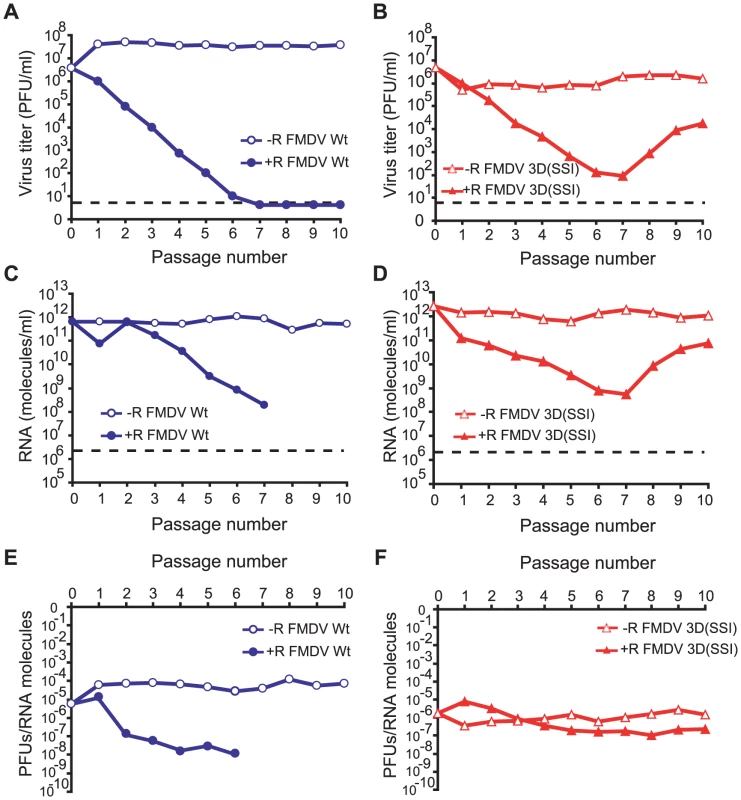
To further substantiate the hypothesis that substitutions P44S, P169S and M296I confer a selective advantage in the presence of R but not in the presence of another mutagen that induces a different mutational repertoire, growth-competition experiments between FMDV Wt and FMDV 3D(SSI) were carried out in the presence of either R or FU (a mutagen which induces mainly U→C and A→G transition in FMDV [58], [60]) or a mixture of R and FU. The results (Table 6) show that a selective advantage of FMDV 3D(SSI) was manifested in the competitions carried out in the presence of R, but not in the presence of FU or of a mixture of R and FU.
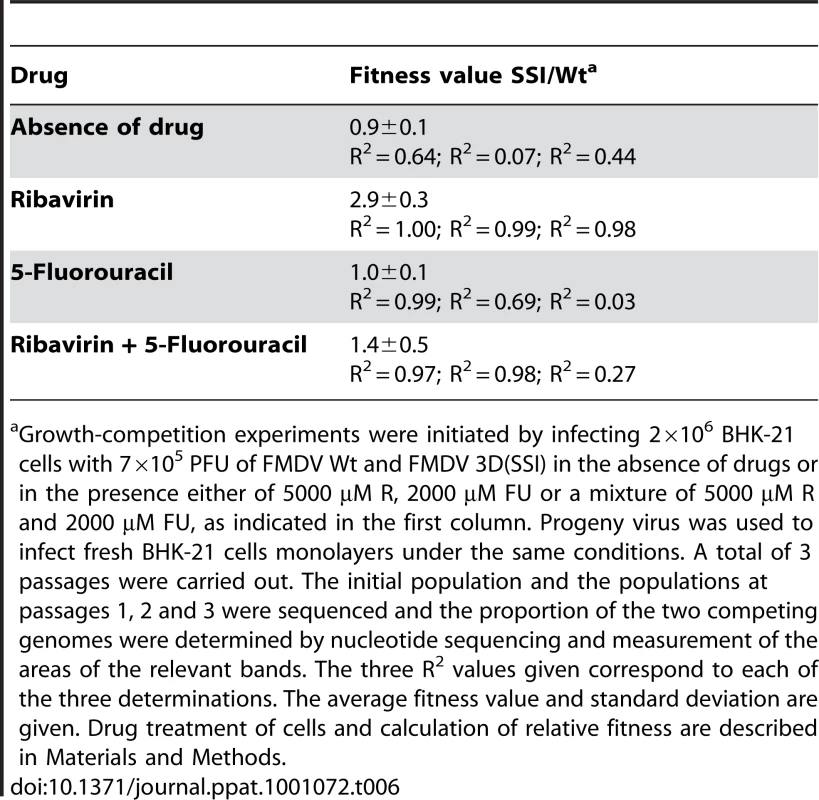
Substitution P44S decreases 3D activity
To investigate the effects of substitutions P44S, P169S and M296I on 3D activity, the wild type polymerase (termed 3DWt), the polymerases that include the individual substitutions [termed 3D(P44S), 3D(P169S) and 3D(M296I)] and the polymerase with the three substitutions [termed 3D(SSI)] were purified as detailed in Materials and Methods and compared in RNA polymerization, VPg-uridylylation and RNA-binding assays (Table 7). 3D(P44S) and 3D(SSI) showed lower activity than the other enzymes in poly(rU) synthesis and in binding to heteropolymeric RNA. In addition, 3D(P44S) displayed a modest decrease in VPg-uridylylation activity. The comparison of activity values in vitro suggests that amino acid P44S inflicted a cost upon 3D function.
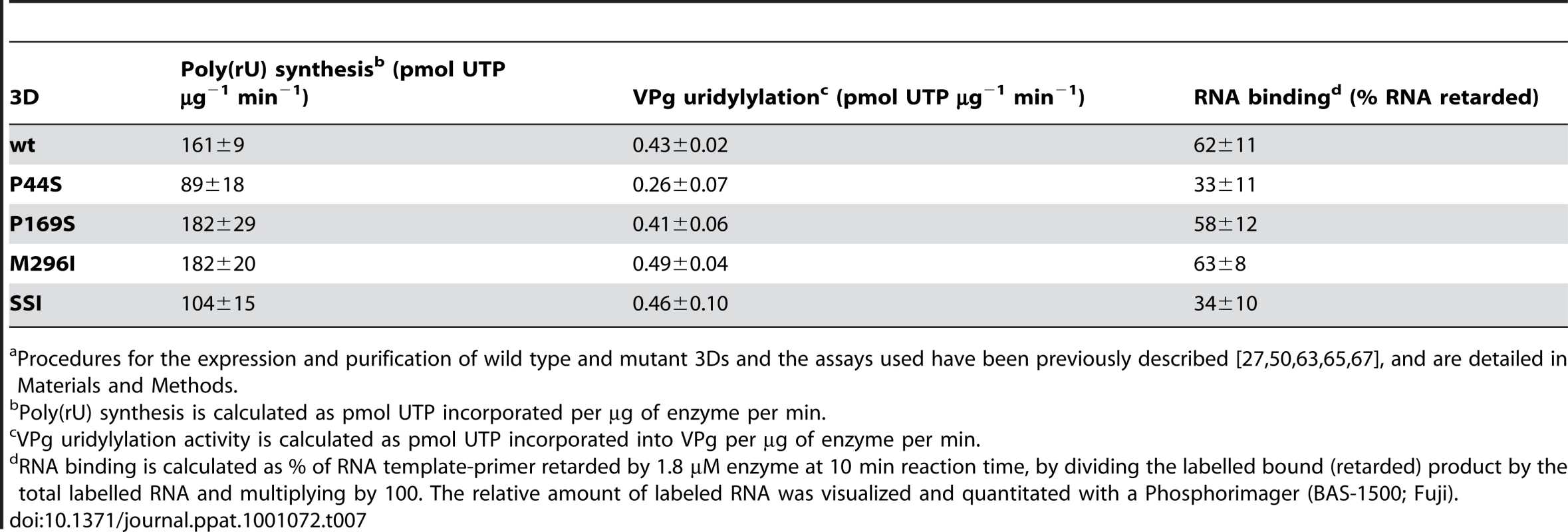
Mutant polymerase 3D(SSI) is deficient in the incorporation of ribavirin-5′-triphosphate and shows a bias to favor misincorporation of RMP opposite U
Previous studies documented that 3D(M296I) displayed a defect in the incorporation of RTP opposite either U and C, in comparison with 3D Wt [27], [50]. The capacity of 3DWt, 3D(P44S), 3D(P169S), 3D(M296I) and 3D(SSI) to use RTP as substrate, and to incorporate RMP opposite U and C was investigated using two symmetrical/subtrate template-primer RNAs [62], termed sym/sub-AC and sym/sub-AU (AC and AU indicate the two template residues that direct the elongation of the primer RNA in two positions, and that allow quantification of the incorporation of R at position +2, opposite C and U, respectively) (Figures 4 and 5). No significant differences in the incorporation GTP of and ATP by 3DWt and 3D(SSI) were observed. Additional experiments were carried out using 1 µM GTP or ATP at 37°C or 33°C, with sym/sub-AC, sym/sub-AU, sym/sub-C and sym/sub-U; again, no differences in the incorporation by 3DWt and 3D(SSI) were observed (Supplementary material, Figures S1, S2, S3). In all cases, the mutant 3Ds were less efficient in RMP incorporation than 3DWt. Interestingly, the incorporation of RMP opposite C was 3-fold lower for 3D(SSI) than for 3D(M296I), but no such difference was observed when the incorporation of RMP was measured opposite U (Figure 5). 3D(P44S) displayed undetectable incorporation of RMP opposite C in the template (<0.5% of elongated sym/sub-AC), and only a modest incorporation opposite U (5±1% of elongated sym/sub-AU). Thus, the incorporation of RMP by 3D(P44S) is at least 10-fold more efficient opposite U than opposite C, suggesting that P44S is the substitution responsible for the biased repertoire of transition mutations during replication of FMDV 3D(SSI) in the presence of R. Comparison of the results of 3D activity (Table 7) and of RMP incorporation (Figures 4 and 5) suggests that substitutions P169S and M296I could exert some compensatory effect to confer 3D with P44S a sufficient polymerization activity while maintaining a limited and biased RMP incorporation. The specific bias displayed by 3D(SSI) against incorporation of RMP opposite C determined in vitro, is consistent with the proportion of transition types observed during replication of FMDV 3D(SSI) in the presence of R during infections of BHK-21 cells (compare Figures 4, 5 and Table 5). FMDV 3D(SSI) populations did not display a significantly lower mutant spectrum complexity than FMDV Wt (Table 5), suggesting that the biased incorporation of R is not directly linked to a significant change in the average template copying fidelity as regards the misincorporation of standard nucleotides. However, this point is under further investigation.

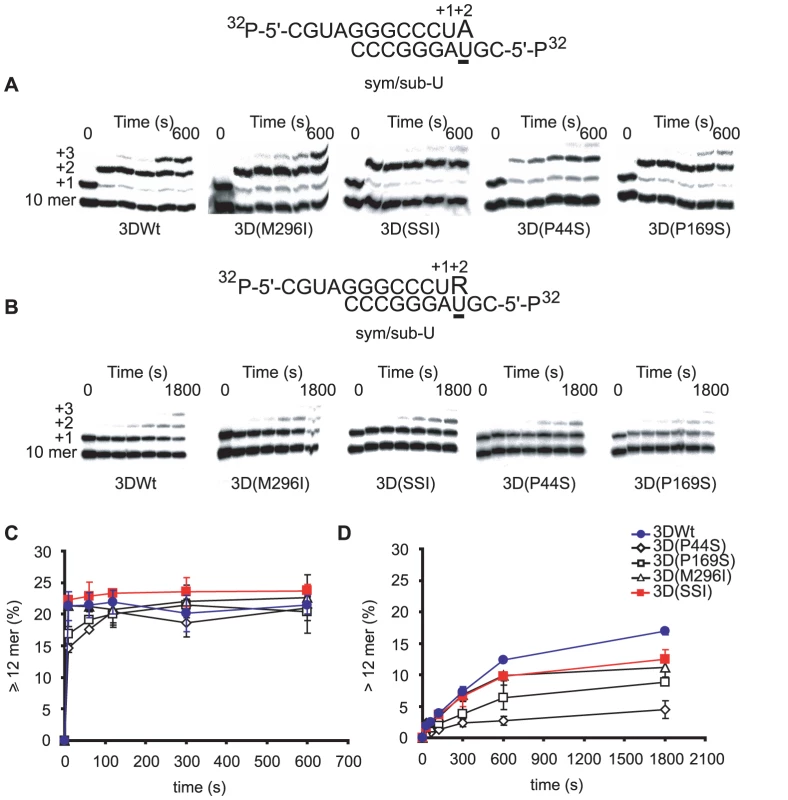
The structure of the 3D mutant polymerases and their complexes with RNA
To identify possible structural modifications of the viral polymerase associated with the important alterations of the mutational spectrum in progeny RNA, and to investigate how these modifications can affect RNA binding and polymerase activity, the different mutant 3Ds were incubated with the heteropolymeric sym/sub-U RNA of sequence 5′GCAUGGGCCC3′, crystallized, and analyzed by X-ray diffraction. Sym/sub - U indicates that U is the template residue which directs the incorporation of A to produce a +1 elongation product. This is the same RNA used in our previous structural studies with FMDV 3D [63]–[65] (see Materials and Methods). For the structural comparisons RNA residues are numbered starting at the 5′ terminal nucleotide.
Two different crystal forms were obtained (Table 8); the single mutants 3D(P44S) and 3D(P169S) incubated with sym/sub-U RNA crystallized in the tetragonal P42212 space group. The RNA molecule appeared mostly disordered in the two structures. In contrast, 3D(SSI) crystallized in the trigonal P3221 space group with the sym/sub-U RNA incorporated in the structure. Since the biochemical results indicate that P44S plays a critical role in the misincorporation of RMP into RNA by 3D, and a 3D(P44S)-RNA complex was not obtained, we attempted the crystallization of the double mutant 3D(P44S, M296I) in complex with RNA. 3D(P44S, M296I) also crystallized in the space group P3221 space group, with the sym/sub-U RNA incorporated in the structure.
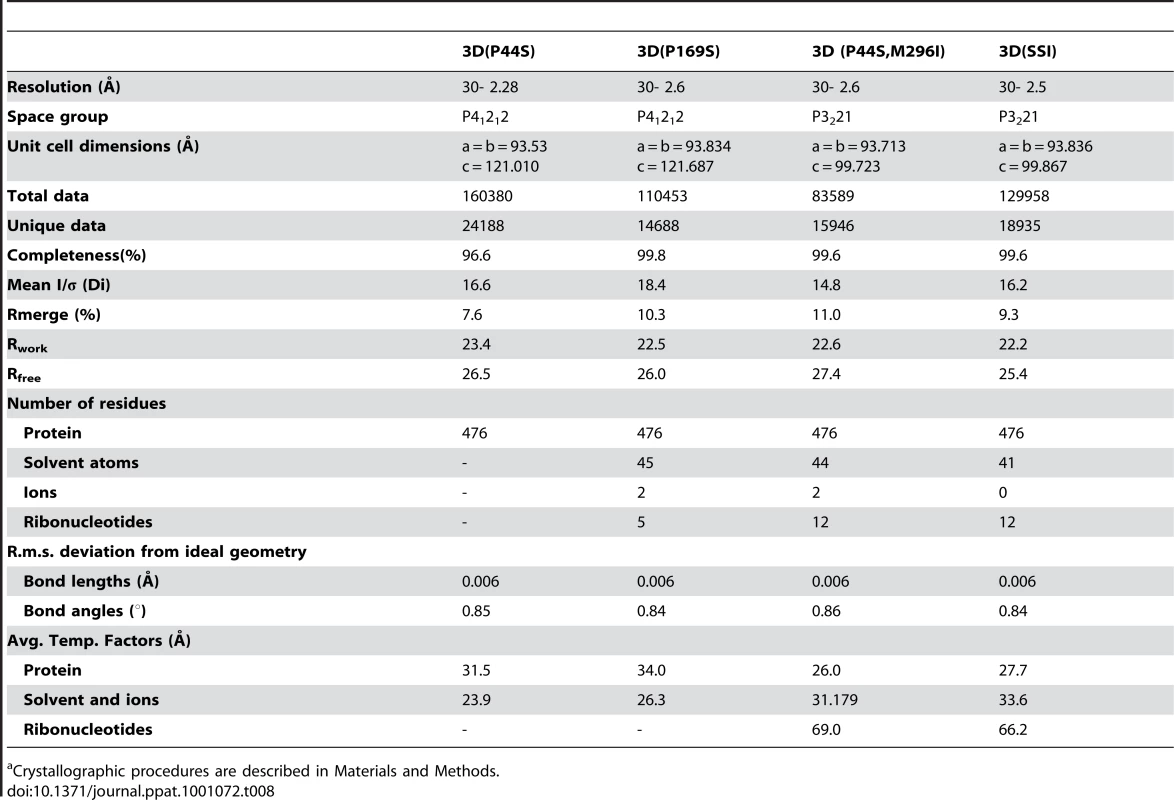
Further attempts to obtain the structures of ternary complexes, using ATP or RTP were unsuccessful, despite using different substrate concentrations and incubation times. The X-ray structures were determined to 2.2 Å and 2.6 Å resolution for 3D(P44S) and 3D(P169S), respectively, and to 2.6 Å and 2.5 Å for 3D(P44S, M296I) and 3D(SSI), respectively (Table 8). The quality of the resulting difference electron density maps allowed the unequivocal tracing of the mutated and surrounding residues that were omitted from the initial models to eliminate model bias (Figure 6). The analysis of the electron density showed also the presence of the duplex portion of the template-primer RNA in the central channel of the polymerase of the trigonal 3D(P44S, M296I) and 3D(SSI) crystals. In addition, two of the four nucleotides of the 5′ overhang moiety (A3 and U4) were reasonably well defined, occupying the template channel, in both structures.
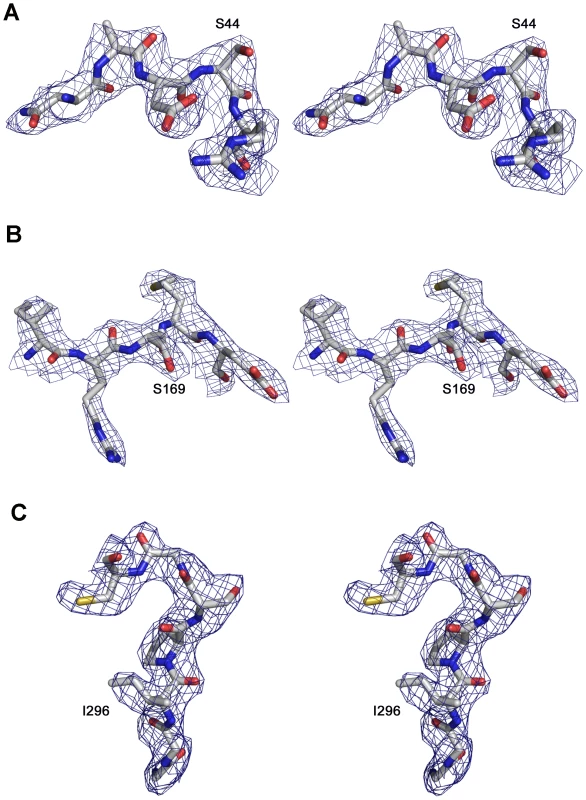
No major structural changes were observed in the polymerase active site when the structures of the different polymerases (either unbound or bound to RNA) were compared. The structural superimpositions of all 476 amino acids residues of 3D(P44S) and 3D(P169S) and of 3D(P44S, M296I) onto the 3D(SSI) showed root mean square deviation (rmsd) values of 0.46Å, 0.35Å and 0.22Å, respectively.
Subtle domain movements, in particular a ∼1° rotation of the thumb domains relative to the fingers, were observed between the unbound, tetragonal, and the RNA-bound, trigonal structures when the individual domains were superimposed. When the unbound and RNA-bound structures were compared for 3DWt a similar small rotation (∼2°) was also observed. As a consequence of this rotation, the active site appeared more closed in the unbound state. Thus, the changes observed seem to be a consequence of either RNA-binding, or of the different packing constraints in the tetragonal and trigonal space groups or both, but they do not seem to be related to the presence of substitutions P44S or P169S.
The 3D(P44S, M296I)-RNA and 3D(SSI)-RNA structures are almost identical (rmsd of the superimposition of all polymerase residues of 0.22Å). These structures are also similar to the structure of 3D(M296I)-RNA mutant complex determined previously (PDB 3KOA; [51]), and to the wild type 3D-RNA complex (PDB 1WNE; [63]), with rmsds of 0.33Å and 0.38Å, respectively. Compared to the wild type 3D, two significant changes are observed in the substituted 3Ds: a conformational change in loop β9-α11 (where substitution M296I lies) and a structural rearrangement of the N-terminus of the polymerase. The conformation and interactions of loop β9-α11 are identical in the 3D(P44S, M296I) and 3D(SSI) complexes, retaining the same structure that was previously observed in 3D (M296I) in complex with RNA [51]. All mutants that contain the substitution M296I show a rearreagement in the loop β9-α11, consisting in a rotation of the peptide bonds Ser298-Gly299 and Cys300-Ser301 (Figure 7). These residues were found hydrogen bonded to the incoming RTP molecule in the structure of the ternary complex between the wild type 3D-RNA-RTP [65], and also interacting with the template acceptor nucleotide in all structures analyzed [51], [65], [66] (Figure 7).
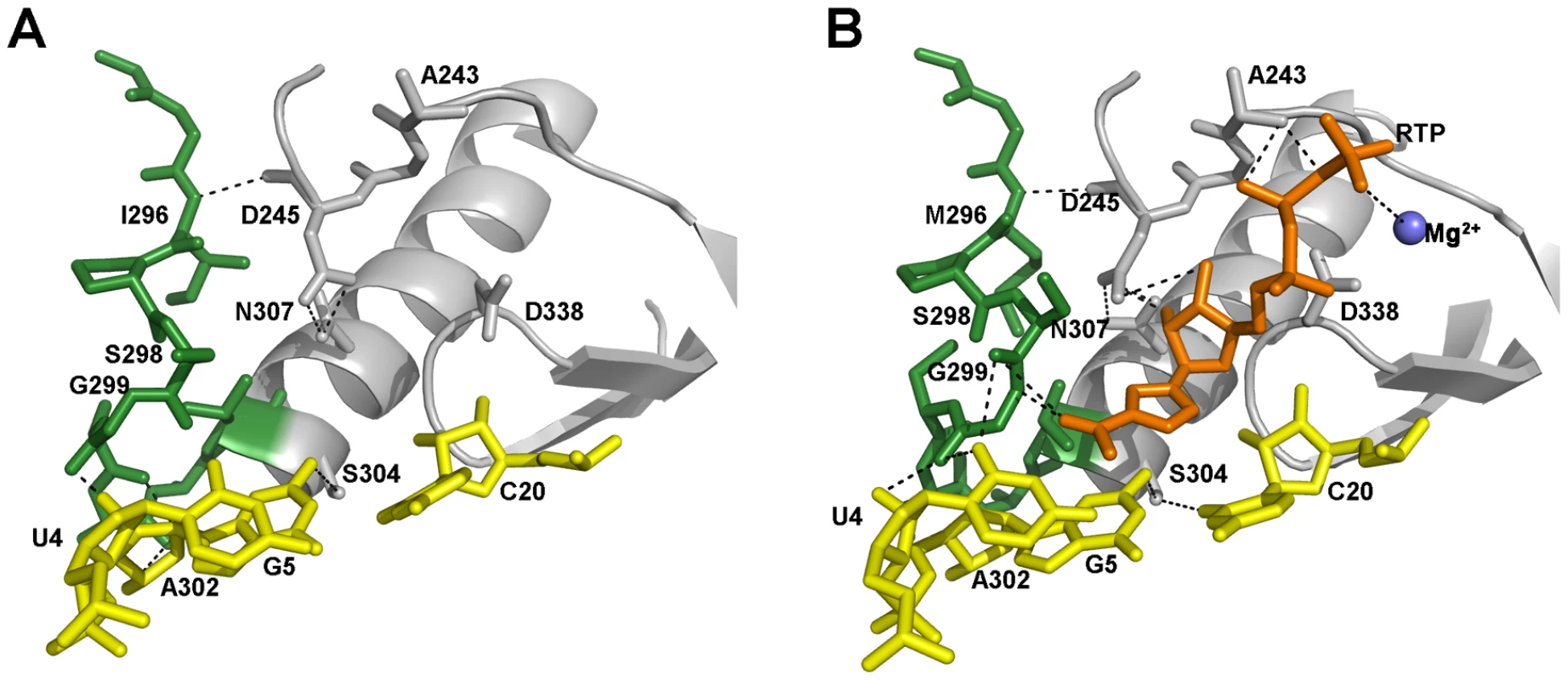
Interestingly, the amino acid residues from M16 to K18, at the N-terminus of the enzyme, appear totally re-organized (Figure 8). This region, together with residues T115 to A122 of motif G and amino acids Q160, F162 and T181 of motif F, form the template channel that binds the 5′ overhang region of the template, driving the ssRNA to the active site cavity [64]. The structures of the wild type 3D-RNA elongation complexes as well as the structure of the mutant 3D(M296I)-RNA complex show that R17 interacts with the sugar-phosphate backbone of template nucleotide A3 that is oriented towards the active site cavity (Figure 9; [64], [65]). In 3D(P44S, M296I)-RNA and 3D(SSI)-RNA complexes the re-oriented residue R17 points to the polymerase interior, interacting with the side chain of residues N41 (which lies in the same loop of the substituted amino acid S44), and with Y285. Nucleotide A3 appears also reoriented, flipped-out towards a pocket formed by amino acids M16, P117, G118, Q160, F162, V181 and V183 (Figure 8). These structural results indicate that the small movements in the loop, that contains the substituted residue S44, facilitate the large conformation changes of the 3D N-terminal residues M16-K18, and the reorientation of the template nucleotide A3. The rearrangements in M16-K18 were also observed in the uncomplexed 3D(P44S), but with a weak electron density and higher temperature factors than the average, reflecting some degree of flexibility of this region in the absence of RNA.
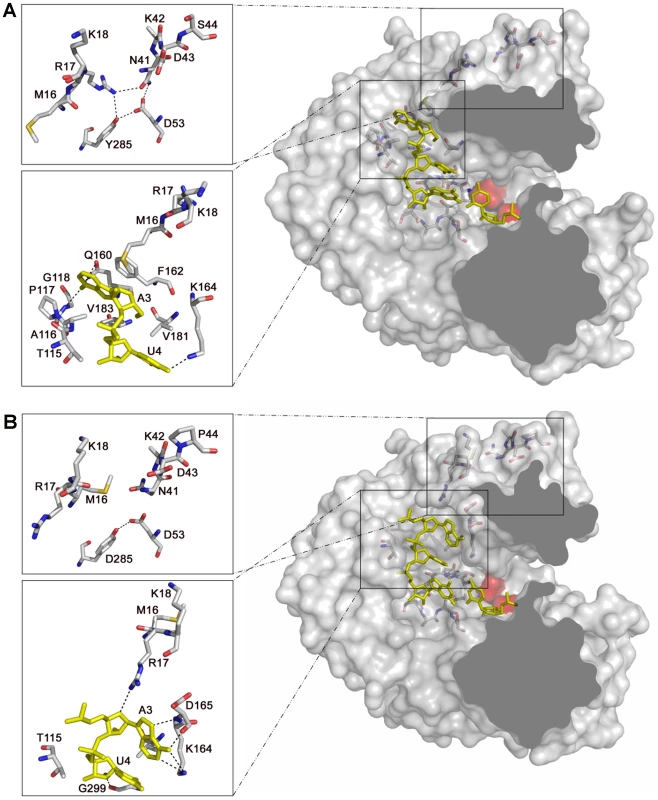
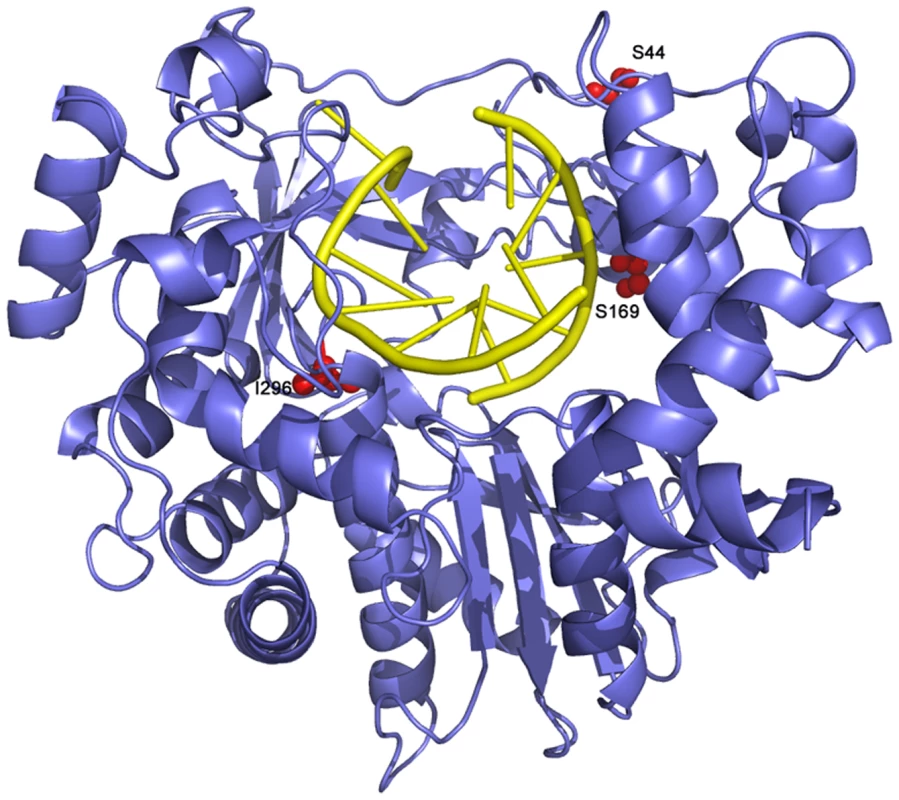
Finally, no significant structural changes were observed associated with substitution P169S. Thus, the structural results point at P44S as the key substitution related to reorientation of template residues that might be associated with altered RMP recognition and incorporation.
Discussion
The great adaptive capacity of RNA viruses to adverse environmental conditions has been fully manifested in the present study with the selection of mutant polymerases capable of biasing the incorporation of RMP so as to modulate the overall mutation types in progeny genomes. The adaptation of FMDV to high R concentrations was mediated by the sequential selection of M296I, P44S and P169S in 3D, with P44S being the main responsible for maintaining a balance of transition types in progeny RNA synthesized in the presence of R. The three amino acid substitutions in 3D were the result of mutation types that are favored during replication of FMDV in the presence of R: a G→A transition in the case of M296I, and a C→U transition in the case of P44S and P169S. Except for P44S and P169S when present individually in 3D, the substitutions in 3D had as consequence a modest but consistent decrease in viral fitness when measured in the absence of R. None of the three replacements in 3D has been previously observed in FMDV C-S8c1 populations (or their mutant spectra) passaged in the absence of R or in the presence of FU or 5-azacytidine [16], [27], [42], [53], [58]–[60], [67]–[71]. Thus, they were selected as a specific response to R and, as expected, the combination of the three substitutions increased FMDV fitness during virus replication in the presence of R (Table 4). Remarkably, the selective advantage of FMDV expressing 3D with the triple combination P44S, P169S, M296I over virus expressing 3D with P44S and M296I was manifested in growth-competition experiments carried out in the presence of 5000 µM R but not in the presence of 800 µM R. Thus, P169S appears to have been selected to contribute a fitness increase in the presence of high R concentrations to a virus that had already acquired the capacity to modulate the mutational spectrum through substitution P44S in 3D. Additional growth-competition experiments between wild type and the triple mutant FMDV indicated that the substituted polymerase conferred a selective advantage when the virus replicated in the presence of R but not of FU or a mixture of R and FU, supporting a specific adaptative response in front of ribavirin (Table 6). The result is consistent with the fitness advantage of R-Ap60 over Ap35 in the presence of R but not of FU+GuH (Table 2). Since FU tends to evoke the opposite transition types than R [58], [60], the outcome of the competitions reinforces modulation of transition types as a major factor for the survival of FMDV 3D(SSI) in the presence of ribavirin.
It may be argued that selection of the multi-substituted polymerase occurred as a result of subjecting the virus to extremely large ribavirin concentrations, unlikely to be reached during any standard antiviral treatment with R. Certainly, the concentrations used were not intended to reproduce actual R concentrations in the course of treatments with R in clinical practice. In the case of direct aerosol application of R to the upper respiratory tract the drug may reach intracellular concentrations of around 800 µM [72], [73]. Other modes of administration are unlikely to achieve such high concentrations. For example, intravenous administration of R results in peak concentrations in the range of 20 µM to 150 µM [74], [75] while oral administration resulted in concentrations between 10 µM and 20 µM in serum and cerebrospinal fluid [74], [76]–[78]. Thus, unless procedures for targetted delivery of R to specific cells or tissues are developed, it is unlikely that concentrations equivalent to those used in our experiments would be encountered in vivo. Do the high concentrations of R used in our experiments weaken the relevance of the conclusions? We think not for two reasons: (i) the actual concentration of RTP in the replication complexes of viruses is unknown, and it cannot be excluded that methods of targetted delivery could be developed that result in high local RTP concentrations; (ii) extreme environmental conditions (a prolonged plaque-to-plaque passage regime, passages in the presence of monoclonal antibodies, etc.) have previously been used to unveil either evolutionary responses or the sensitivity of biochemical processes to subtle genetic change [1], [69], [79]. Thus, our model studies must be regarded as designs to disclose potential mutagen-resistance mechanisms that are informative of the potential of the polymerase to adapt its catalytic machinery to extraneous substrates, despite using conditions unlikely to be encountered in vivo.
The virological and biochemical evidence presented here support the hypothesis that the polymerase substitutions, whose effect was to avoid a highly biased distribution of mutation types normally induced by a mutagenic agent, contributed to viral survival and escape from extinction (Figure 3), implying a new mechanism of virus resistance to lethal mutagenesis. This new mechanism does not require significant reductions of mutant spectrum complexity thereby preserving an amplitude of the mutant cloud adequate for virus adaptability to complex environments or following a bottleneck event [1], [28]–[30]. The balanced mutational spectrum produced by FMDV 3D(SSI) was maintained in the absence or presence of 5000 µM R, while FMDV Wt produced a mutant spectrum with 80% (C→U)+(G→A) only after 4 passages in the presence of 5000 µM R (Table 5). A deleterious effect of biased substitution types is likely because they can affect codon usage and specific RNA structures needed during viral replication [80]–[85]. Examination of the repertoire of mutations (and corresponding amino acid substitutions) present in the mutant spectra of FMDV Wt and FMDV SSI passaged in the presence of 5000 µM R is highly illustrative of the deleterious effects of the incapacity of the polymerase to modulate transition types (Table 9). First, the proportion of non-synonymous mutations relative to the number of nucleotides sequenced is 1.5-fold higher for R-Wt-4 than for R-SSI-4. Second, in the R-Wt-4 population a stop codon was generated as a result of a G→A transition at genomic position 7319, and 74% of the 27 amino acid substitutions scored were the result of C→U or G→A transitions. In contrast, of the 15 amino acid substitutions in R-SSI-4 only 20% were the result of C→U or G→A transitions. The most salient amino acid substitutions found in population R-Wt-4 are G125R, C300Y and G435E, each originated from a G→A transition (Table 9). These residues are conserved among picornaviruses and the substitutions observed might have relevant structural effects. G125R is an infrequent substitution that introduces a bulky residue that was tolerated probably because it lies in an exposed region at the entrance of the template channel [63], [64]. C300 is located in loop β9-α11, and its main chain interacts with the rNTP and the acceptor base of the template RNA. In the complex with RTP, the G299-C300 peptide bond is rotated in a way that favors the interaction with the pseudobase [65] (Figure 7). Replacement of C by Y is likely to affect the flexibility of this region and, as a result, the interactions with RNA and the rNTP. G435 is located in a short turn between helices α14 and α15 in the thumb domain, a region which is rich in small and flexible amino acids [63]. The introduction of an E residue in this region is not expected, and it might affect the stability of this 3D region. In contrast to R-Wt-4, among the amino acid replacements found in the R-SSI-4 populations, the most noticeable is K164E located in motif F of 3D. K164 is not among the basic amino acids that interact with the incoming rNTP, but it is hydrogen bonded to template base A3 [63]. An E residue could participate in the same interaction, as also observed between 3D residue D165 and base U4 in the same complex [63]. Thus, the comparison of the mutant repertoire in R-Wt-4 and R-SSI-4 reinforces the likely adverse effects of an abundance of C→U and G→A transitions for FMDV fitness. It is not clear whether the most detrimental factor is the imbalance of mutation types by itself, or the increased frequency of U and A residues in genomic RNA, or a combination of both factors. Whatever the mechanism, the results suggest that the maintenance of a suitable transition pattern during RNA synthesis in an environment of high mutational pressure can be beneficial for the virus under increased average mutation rates.

Despite the clear virological and biochemical effects of substitutions P44S, P169S and M296I in 3D, the comparison of fitness values for clones and populations indicates that it is unlikely that the replacements in 3D are the only determinants of high level resistance to R. Indeed, the fitness of the uncloned FMDV population R-Ap60 was 15-fold higher than the fitness of control population Ap35, when measured in the presence of 5000 µM R, while the fitness of the cloned FMDV 3D(SSI) was 2-fold higher than the fitness of the cloned FMDV Wt, measured under the same conditions (Tables 2 and 4). There are two main possibilities to account for the larger difference of fitness between FMDV R-Ap60 and Ap35 than between FMDV 3D(SSI) and FMDV Wt. One is that the complexity or composition of the mutant spectrum of R-Ap60 conferred a selective advantage to the mutant ensemble that could enhance R resistance, even in the absence of additional dominant mutations (or mutations in their way to dominance). Recent observations on the selective value of mutant spectrum complexity and composition [1], [29], [53], [71], [86], [87] do not permit excluding this possibility. An alternative, not mutually exclusive possibility, is that mutations in genomic regions of FMDV other than 3D contribute also to R resistance in RAp60. Current evidence suggests that non-structural protein 2C may also contribute to FMDV escaping extinction (Agudo et al., manuscript in preparation).
P44 is conserved among known picornaviral polymerases, and it lies in a loop that connects strand β2 and helix α2 in the fingers domain (Figure 9). This loop contains a number of residues that establish tight contacts with amino acids V173 to G176 of motif F and with the N-terminal residues M16, R17 and K18 of 3D. Amino acids M16 and R17 form part of the template channel that drives the ssRNA template towards the active site. Thus, substitutions at the conserved amino acid P44 might disturb both the shape and interactions of the template channel, and the interactions with the incoming rNTP that are mediated by residues of motif F.
The structures of the mutant polymerases determined in the present study do not show large domain movements. However, the crystal structures of 3D(P44S, M296I) and 3D(SSI) in complex with the RNA template-primer reveal a rearrangement in the template channel with important effects in template binding, in particular, at position n+1 (nucleotide A3). The conformational changes in the main and side chains of residues M16 and R17 allow the opening of a hydrophobic pocket formed by residues of motifs G and F and by M16 that facilitates the entrance of nucleotide A3 (Figure 8). The polymerase with substitution M296I that acquired substitution P44S maintained the alteration of loop β9-α11 previously described for 3D (M296I) [51] (Figure 8). Thus, the catalytic domain and template interactions may be affected by additive effects of substitutions M296I and P44S. The different interactions established between the modified template channel of the substituted polymerases and nucleotide A3 could facilitate a different alignment of the template strand, thus altering the nucleotide incorporation activity. However, this possibility has not been substantiated because of the inability of nucleotide substrates to be incorporated into the mutant 3D-RNA complexes.
Finally, P169 is a non-conserved residue located in motif F of 3D (Figure 9) that has been implicated in the recognition of the triphosphate moiety of the incoming nucleotide. P169 is close to 3D residues that directly contact with either the triphosphate or ribose moieties of the incoming nucleotide [63], [88]. The structural comparisons do not reveal any conspicuous change in the polymerase induced by substitution P169S. However, we can not exclude that a change at this position could also affect the recognition of an incoming nucleotide, modulating its incorporation rate, and thus altering the replication fidelity or replicative fitness. Thus, subtle structural modifications that affect the template channel of 3D mediate alterations in substrate recognition that may modify recognition of RTP and the repertoire of R-mediated mutations.
Materials and Methods
Cells, viruses, infections, and cytotoxicity of ribavirin
The origin of BHK-21 cells, procedures for cell growth and for infection with FMDV in the presence or absence of ribavirin (R; Sigma), 5-fluorouracil (FU; Sigma), or guanidine hydrochloride (GuH; Sigma) have been previously described [27], [53], [54], [59]. Briefly, for each infection the first passage was carried out at moi 0.3 PFU/cell. For the following passages, 2×106 BHK-21 cells were passaged with supernatant of virus from the previous passage (0.2 ml), and the infection allowed to proceed for about 24h. Values of PFU for each passage can be estimated from infectivities given in Figure 3. FMDV C-S8c1 is a plaque-purified derivative of natural isolate C1 Santa-Pau Spain 70 [54], a representative of European serotype C FMDV. FMDV MARLS is a monoclonal antibody-escape mutant selected from the C-S8c1 population passaged 213 times in BHK-21 cells [69]. Ap35 and R-Ap35 are FMDV MARLS passaged 35 times in the absence or in the presence, respectively, of increasing concentrations of R as previously described [27]; FMDV MARLS populations passaged 45 and 60 times in the presence of increasing concentrations of R have been termed R-Ap45 and R-Ap60 (see Figure 1). R exerted a cytostatic effect in BHK-21 cell monolayers (measured as cell viability using trypan blue staining). The cytotoxicities as a result of treatment of BHK-21 cell monolayers with R, FU and GuH have been previously described [53], [58], [59]. The maximum reduction of cell viability of confluent BHK-21 cell monolayers in the presence of 5000 µM R was around 40% at 48 h post-treatment, in agreement with our previous results [53]. Evidence that cytotoxicity by R does not contribute significantly to FMDV extinction includes the observation that FMDV mutant with amino acid replacements in 3D that confer resistance to R can replicate and survive after multiple passages in the presence of 5000 µM R (Figure 3, and unpublished observations).
Extraction of RNA, cDNA synthesis, PCR amplification, and nucleotide sequencing
RNA was extracted from the supernatants of infected cells using described procedures [27], [67]. Reverse transcription (RT) was carried out using AMV reverse transcriptase (Promega), and PCR amplification was performed using EHF DNA polymerase (Roche) as specified by the manufacturer. RT-PCR amplification intended for the cloning of individual cDNA molecules was carried out using Pfu ultra DNA polymerase (Stratagene). Amplification protocols, nucleotide sequencing and primers used for amplification and sequencing have been previously described [27], [42], [67].
Quantification of viral RNA
FMDV RNA was quantified by real-time RT-PCR amplification using the Light Cycler instrument (Roche) and the RNA Master SYBR green I kit (Roche) as previously described [27].
Preparation of FMDV C-S8c1 with substitutions in 3D
Plasmid pMT28 encodes an infectious transcript of FMDV C-S8c1 [57], [70]. The construction of plasmid pMT28-3D(M296I) (an infectious clone expressing 3D with substitution M296I in the context of the C-S8c1 genome) has been previously reported [27]. The rest of chimeric plasmids encoding mutant 3Ds were constructed by replacing part of the 3D-coding region of pMT28 with the corresponding mutant 3D-coding region of interest. To construct pMT28-3D(P169S) (an infectious clone encoding 3D with amino acid substitution P169S in the context of the C-S8c1 genome), two DNA amplifications were carried out using Pfu ultra DNA polymerase and pMT28 DNA as template. A first amplification with 3AR3 (GATGACGTGAACTCTGAGCCCGC; sense, 5′ position 5710) and 3′3DP169S (CTTTCTCCATGCTGCGAATTTCGTCCTTCAGGAAGG; antisense, 5′ position 7126); and a second amplification with 5′3DP169S (CGAAATTCGCAGCATGGAGAAAGTACGTGCCGG; sense, 5′ position 7104) and 3D1 (CTTGTTGCGGAACAGCCAGATG; antisense, 5′ position 7520) were performed (bold-face letters indicate modifications of the genomic sequence introduced to express 3D with substitution P169S). (Nucleotide positions correspond to the numbering of FMDV genomic residues described in [69]). The two amplicons were shuffled and digested with RsrII (position 5839) and ClaI (position 7004) (New England Biolabs) and ligated to pMT28 DNA linearized with the same enzymes. A similar procedure was used to construct pMT28-3D(P44S) and pMT28-3D(P44S, M296I). To prepare pMT28-3D(P44S,M296I) (an infectious clone expressing 3D harboring substitution P44S and M296I in the context of the C-S8c1 genome), pMT28-3D(M296I) was subjected to the same procedure described above for pMT28, except that the two pairs of primers used for the PCR amplification were 3AR3 (described above) with 3′3DP44S (CGTTCAGACGGCTGTCCTTGTTAGACAAGGCGG; antisense, 5′ position 6751), and 5′3DP44S (CTAACAAGGACAGCCGTCTGAACGAAGGTG; sense, 5′ position 6728) with A3 (CGTCGACAATGCGAGTCTTGCCG; antisense, 5′ position 7156; bold-face letters indicate modifications of the genomic sequence introduced to express 3D with substitution P44S). The two amplicons were shuffled, digested with RsrII and ClaI, and ligated to pMT28 or pMT28-3D(M296I) DNAs linearized with the same enzymes, rendering pMT28-3D(P44S) and pMT28-3D(P44S, M296I), respectively. Finally, to construct pMT28-3D(P44S, P169S, M296I) (an infectious clone expressing 3D with amino acid substitution P44S, P169S and M296I in the context of the C-S8c1 genome), procedures were carried out as those described for pMT28-3D(P169S) except that the parental plasmid used both as template for DNA amplifications and for cloning was pMT28-3D(P44S, M296I) instead of pMT28. For simplicity, the plasmid that includes the three amino acid substitutions in 3D has been termed pMT28-3D(SSI) and the rescued virus FMDV 3D(SSI).
Ligation, transformation of E. coli DH5α, colony screening, nucleotide sequencing, preparation of infectious RNA transcripts, and RNA transfections were carried out as previously described [27], [67].
Quasispecies analysis
To determine the complexity of mutant spectra, FMDV RNA was extracted as described above and subjected to RT-PCR using primers PolC-KpnI (GTTGGTACCCACTCTGCTGGAGGC; sense, 5′ position 6502) and Pol1-XbaI (AATCTAGATGTTTGGGGGATTATGCG; antisense, 5′ position 8060; the letters underlined indicate the sequences recognized by restriction enzymes KpnI and XbaI, respectively). cDNA was digested by KpnI and XbaI enzymes (New England Biolabs), and ligated to plasmid pGEM-3Z Vector (Promega) previously digested with the same enzymes. Transformation, colony screening and nucleotide sequencing were carried out as previously described [27], [67]. The region sequenced spans residues 6508 to 8036 and includes the entire 3D-coding region (residues 6610 to 8020). The number of clones analyzed and the total number of nucleotides sequenced are given in the appropriate section of Results. The complexity of mutant spectra was expressed as the mutation frequency, calculated by dividing the number of different mutations by the total number of nucleotides sequenced.
Fitness assays
Relative fitness was measured by growth-competition experiments in the presence or absence of R. The logarithm of the ratio of the two competing viruses was plotted against passage number, and the fitness vector was adjusted to an exponential equation y = a×ebx. The antilogarithm of the vector slope is the fitness of the virus tested, relative to that of the reference virus [27], [68]. The proportion of the two competing genomes at different passages was determined by real-time RT-PCR, employing primers specifically designed to discriminate accurately the two RNAs in the competition (Table 10). For each fitness determination, the R2 value of the corresponding linear regressions is also given (Tables 2 and 4).
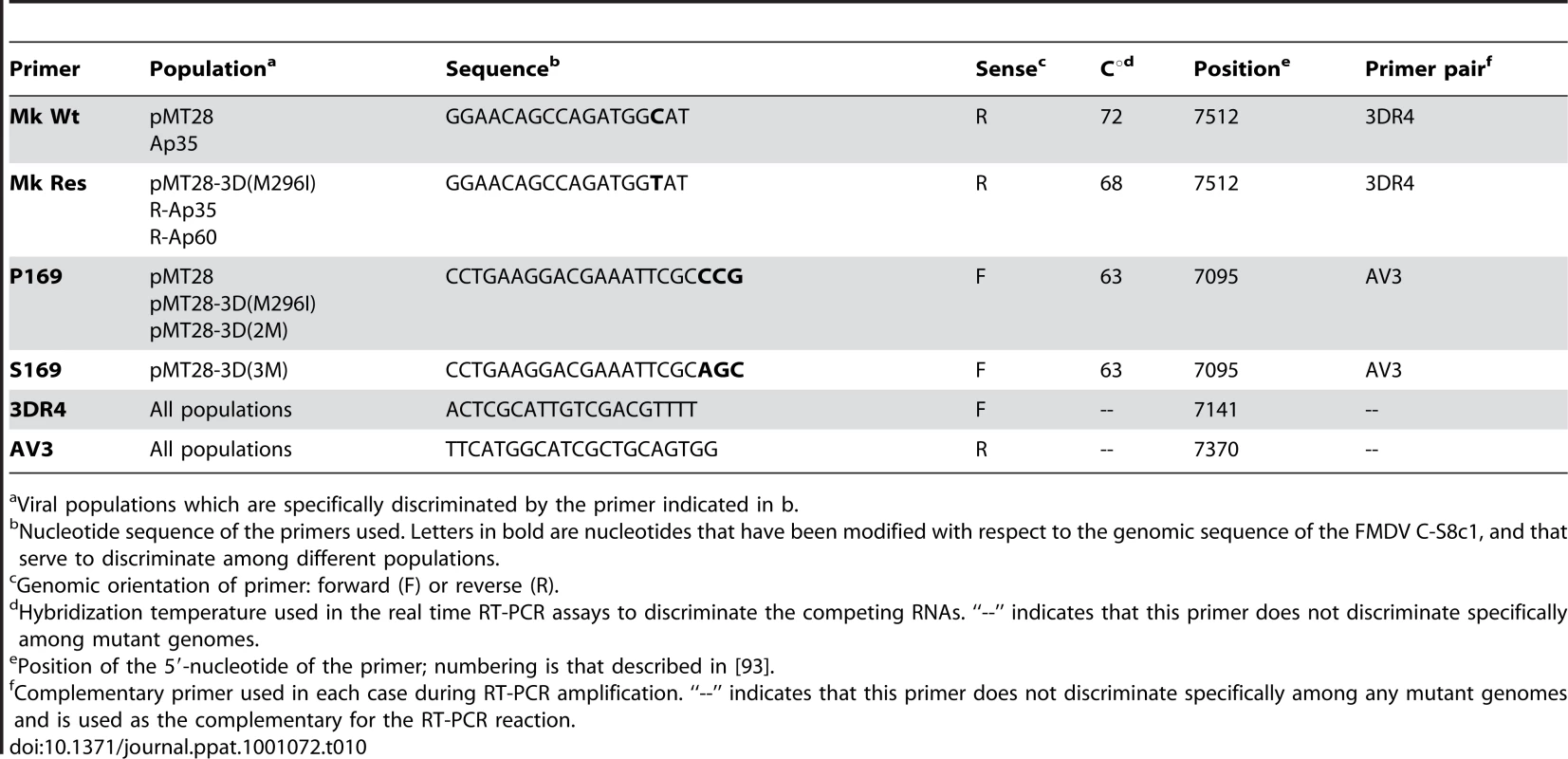
Fitness assays in the presence of ribavirin, 5-fluorouracil and a mixture of both drugs
A solution of ribavirin (R) in PBS was prepared at a concentration of 100 mM, sterilized by filtration, and stored at −70°C. Prior to use, the stock solution was diluted in DMEM to reach the desired R concentration. To prepare culture medium containing 5-fluorouracil (FU) (Sigma), the analogue was dissolved in DMEM to yield a 5 mg/ml solution, and diluted in DMEM, as needed for the experiments. For infections in the presence of R (5000 µM) and FU (2000 µM), cell monolayers were treated during 7 h and 10 h, respectively, prior to infection. The relative fitness of FMDV SSI was determined by growth competition with the Wt virus in BHK-21 cells in the presence of R, FU or a mixture of both drugs. Briefly, the viral population to be assayed was mixed with the same number of PFU of FMDV Wt, used as reference. For each determination, four serial infections were carried out at moi 0.3 PFU/cell. The proportion of the two competing genomes at each passage was determined by measuring the area of the three peaks corresponding to the residues that distinguish 3D Wt from 3D(SSI). Each mutation was confirmed by two independent sequencing assays using primers of different orientation. The average of triplicate measurements and standard deviations are given.
Molecular cloning, expression, and purification of FMDV 3D
FMDV 3D with substitutions M296I [termed 3D(M296I)], P169S [termed 3D(P169S)], P44S [termed 3D(P44S)], with P44S and M296I [termed 3D(P44S, M296I)], or with the three of them [3D(P44S, P169S, M296I) which is abbreviated as 3D(SSI)] were obtained from plasmid pET-28a 3Dpol [expression vector pET-28a (Novagen) containing the FMDV polymerase 3D-coding region [67]] by site-directed mutagenesis with oligonucleotides containing the corresponding mutated nucleotides, using the QuickChange site-directed mutagenesis kit (Stratagene). Mutagenesis, 3D expression, and 3D purification by affinity chromatography, were carried out as previously described [63], [67]. The enzymes were >95% pure, as judged by SDS-PAGE electrophoresis and Coomassie brilliant blue staining.
3D-polymerization assays using heteropolymeric template-primers
Incorporation of standard nucleoside-5′-triphosphates or ribavirin-5′-triphosphate (RTP) by wild type and mutant 3Ds was measured in self-complementary RNAs that form double stranded RNA in which each strand can act both as template and primer [62]. RNAs 5′-CGUAGGGCCC-3′ (termed sym/sub-AU), 5′-UGCAGGGCCC-3′ (termed sym/sub-AC), 5′-GUACGGGCCC-3′ (termed sym/sub-C) and 5′-GCAUGGGCCC-3′ (termed sym/sub-U) (Dharmacon Research) were used. The oligonucleotides were purified, end-labeled with [γ-32P] ATP and polynucleotide kinase (New England biolabs), and annealed using standard protocols [27], [89]. For the reaction with sym/sub-AU and sym/sub-U, 0.5 µM of RNA-duplex and 2 µM 3D were incubated in 30 mM MOPS (pH 7.0), 33 mM NaCl, 5 mM Mg(CH3COO)2, and 50 µM UTP (Amersham) in the case of sym/sub-AU, for either 10 min [for 3D wt, 3D(P169S) and 3D(M296I)] or 30 min [for 3D(P44S) and 3D(SSI)] at 37°C, or 33°C when mentioned; 3D(SSI) and 3D(P44S) were incubated for longer periods of time because they display a defect in RNA binding (see Results). After formation of a binary complex of 3D-RNA, [elongated in one nucleotide in the case of sym/sub-AU (3D-sym/sub-AU, n+1 complexes)], an excess of unlabeled sym/sub-AU (5 µM) was added to trap the unbound 3D, and to avoid the recycling of labelled sym/sub-AU. The reaction was initiated by adding either 50 µM ATP (Amersham) or 50 µM (RTP) (Moraveck), or 1µM ATP when mentioned. The reaction was stopped at different times by the addition of EDTA (83 mM final concentration). Identical procedure was followed with sym/sub-AC, except that GTP and RTP were used as substrates. Reaction products were analyzed by electrophoresis on a denaturing 23% polyacrylamide, 7 M urea gel in 90 mM Tris-base, 90 mM boric acid, 2 mM EDTA. The 11 mer (sym/sub elongated in one nucleotide by addition of UMP) and ≥12-mer (sym/sub elongated in two or more nucleotides by addition of the required nucleotides) were visualized and quantitated with a Phosphorimager (BAS-1500; Fuji).
Other assays with 3D
Poly(rU) synthesis using poly(A)-oligo(dT)15 as template-primer molecule, VPg uridylylation with poly(A) as template and Mn++ as ion, and RNA binding assays were carried out as previously described [67], [89].
Co-crystallization experiments
Purified FMDV mutant polymerases 3D(P44S), 3D(P169S), 3D(P44, M296I) and 3D(SSI) were stored in a buffer containing Tris-HCl (40mM, pH 7.5), NaCl (0.5M), DTT (0.8mM), EDTA (0.8mM), and glycerol (8%), at a concentration of ∼4.6 mg/ml. The oligonucleotide 5′GCAUGGGCCC 3′ (NWG-Biotech) (sym/sub-U) was annealed following the described procedure [62]. Then the 3D was added slowly to an equimolar proportion in the presence of 2mM MgCl2. The mutant 3Ds and their complexes were crystallized as previously described [63].
Data collection, structure determination and refinement
Four different data sets were collected at 100 K: 3D(P44S) (2.2 Å), 3D(P169S) (2.6 Å), 3D(P44, M296I)-RNA (2.6 Å) and 3D(SSI)-RNA (2.5 Å), using synchrotron radiation at the ESRF beamlines ID14 EH1 and EH2 (λ = 0.93 Å). All data were processed and reduced using DENZO/SCALEPACK package [90] (Table 8).
The initial maps for the 3D(P44S) and 3D(P169S) (tetragonal crystals) were obtained after a rigid body fitting of the coordinates of isolated 3D protein that was crystallized in the tetragonal p42212 space group (PDB:1U09) [63] to the new unit cells, using the program REFMAC (CCP4). Initial maps for the 3D(P44, M296I)-RNA and 3D(SSI)-RNA complexes (P3221 crystals) were obtained following the same procedure but using the trigonal P3221 coordinates of 3D (PDB:1WNE) [63] as starting model (Table 1). In the four structures the 2|Fo|-|Fc| and |Fo|-|Fc| difference maps clearly allowed the re-positioning of the mutated residues and surrounding regions and, in the trigonal structures, these maps showed the presence of extra densities corresponding to the RNA template-primers. However, the tetragonal crystals, 3D(P44S) and 3D(P169S), did not contain RNA despite using the same incubation and co-crystallization conditions as in 3D(P44, M296I)-RNA and 3D(SSI)-RNA complexes that crystallized in the P3221 space group. Several cycles of automatic refinement, performed with program REFMAC, were alternated with manual model rebuilding using the graphic programs TURBO and Coot [91]. The statistics of the refinement for the four complexes are summarized in Table 7.
Supporting Information
Zdroje
1. DomingoE
2006 Quasispecies: Concepts and Implications for Virology. In Curr Top Microbiol Immunol Vol, 299
2. ScheidelLM
DurbinRK
StollarV
1987 Sindbis virus mutants resistant to mycophenolic acid and ribavirin. Virology 158 1 7
3. RichmanDD
1996 Antiviral Drug Resistance New York John Wiley and Sons Inc
4. DomingoE
1989 RNA virus evolution and the control of viral disease. Prog Drug Res 33 93 133
5. DomingoE
2003 Quasispecies and the development of new antiviral strategies. Progress in Drug Res 60 133 158
6. DomingoE
ParrishC
HollandJJE
2008 Origin and Evolution of Viruses. 2nd edition Oxford Elsevier
7. MasA
López-GalíndezC
CachoI
GómezJ
MartinezMA
2010 Unfinished stories on viral quasispecies and Darwinian views of evolution. J Mol Biol 397 865 877
8. SwetinaJ
SchusterP
1982 Self-replication with errors. A model for polynucleotide replication. Biophys Chem 16 329 345
9. EigenM
2002 Error catastrophe and antiviral strategy. Proc Natl Acad Sci USA 99 13374 13376
10. BiebricherCK
EigenM
2005 The error threshold. Virus Res 107 117 127
11. EigenM
BiebricherCK
1988 Sequence space and quasispecies distribution.
DomingoE
AhlquistP
HollandJJ
RNA Genetics Boca Raton, FL CRC Press 211 245
12. SchusterP
StadlerPF
2008 Early Replicons: Origin and Evolution. Origin and Evolution of Viruses 2nd edition.
DomingoE
ParrishCR
HollandJJ
Oxford Elsevier 1 42
13. OchoaG
2006 Error thresholds in genetic algorithms. Evol Comput 14 157 182
14. HarrisKS
BrabantW
StyrchakS
GallA
DaifukuR
2005 KP-1212/1461, a nucleoside designed for the treatment of HIV by viral mutagenesis. Antiviral Res 67 1 9
15. AndersonJP
DaifukuR
LoebLA
2004 Viral error catastrophe by mutagenic nucleosides. Annu Rev Microbiol 58 183 205
16. DomingoE
ParienteN
AiraksinenA
Gonzalez-LopezC
SierraS
2005 Foot-and-mouth disease virus evolution: exploring pathways towards virus extinction. Curr Top Microbiol Immunol 288 149 173
17. GraciJD
CameronCE
2002 Quasispecies, error catastrophe, and the antiviral activity of ribavirin. Virology 298 175 180
18. HarkiDA
GraciJD
EdathilJP
CastroC
CameronCE
2007 Synthesis of a universal 5-nitroindole ribonucleotide and incorporation into RNA by a viral RNA-dependent RNA polymerase. Chembiochem 8 1359 1362
19. GraciJD
TooK
SmidanskyED
EdathilJP
BarrEW
2008 Lethal mutagenesis of picornaviruses with N-6-modified purine nucleoside analogues. Antimicrob Agents Chemother 52 971 979
20. Ruiz-JaraboCM
LyC
DomingoE
de la TorreJC
2003 Lethal mutagenesis of the prototypic arenavirus lymphocytic choriomeningitis virus (LCMV). Virology 308 37 47
21. CrottyS
CameronCE
AndinoR
2001 RNA virus error catastrophe: direct molecular test by using ribavirin. Proc Natl Acad Sci USA 98 6895 6900
22. HollandJJ
DomingoE
de la TorreJC
SteinhauerDA
1990 Mutation frequencies at defined single codon sites in vesicular stomatitis virus and poliovirus can be increased only slightly by chemical mutagenesis. J Virol 64 3960 3962
23. HofmannWP
PoltaA
HerrmannE
MihmU
KronenbergerB
2007 Mutagenic effect of ribavirin on hepatitis C nonstructural 5B quasispecies in vitro and during antiviral therapy. Gastroenterology 132 921 930
24. LoebLA
EssigmannJM
KazaziF
ZhangJ
RoseKD
1999 Lethal mutagenesis of HIV with mutagenic nucleoside analogs. Proc Natl Acad Sci USA 96 1492 1497
25. LoebLA
MullinsJI
2000 Lethal mutagenesis of HIV by mutagenic ribonucleoside analogs. AIDS Res Hum Retroviruses 13 1 3
26. TapiaN
FernandezG
PareraM
Gomez-MarianoG
ClotetB
2005 Combination of a mutagenic agent with a reverse transcriptase inhibitor results in systematic inhibition of HIV-1 infection. Virology 338 1 8
27. SierraM
AiraksinenA
González-LópezC
AgudoR
AriasA
2007 Foot-and-mouth disease virus mutant with decreased sensitivity to ribavirin: implications for error catastrophe. J Virol 81 2012 2024
28. VignuzziM
StoneJK
AndinoR
2005 Ribavirin and lethal mutagenesis of poliovirus: molecular mechanisms, resistance and biological implications. Virus Res 107 173 181
29. VignuzziM
StoneJK
ArnoldJJ
CameronCE
AndinoR
2006 Quasispecies diversity determines pathogenesis through cooperative interactions in a viral population. Nature 439 344 348
30. PfeifferJK
KirkegaardK
2003 A single mutation in poliovirus RNA-dependent RNA polymerase confers resistance to mutagenic nucleotide analogs via increased fidelity. Proc Natl Acad Sci USA 100 7289 7294
31. PfeifferJK
KirkegaardK
2005 Increased fidelity reduces poliovirus fitness under selective pressure in mice. PLoS Pathogens 1 102 110
32. DavisGL
Esteban-MurR
RustgiV
HoefsJ
GordonSC
1998 Interferon alfa-2b alone or in combination with ribavirin for the treatment of relapse of chronic hepatitis C. International Hepatitis Interventional Therapy Group. N Engl J Med 339 1493 1499
33. McHutchisonJG
GordonSC
SchiffER
ShiffmanML
LeeWM
1998 Interferon alfa-2b alone or in combination with ribavirin as initial treatment for chronic hepatitis C. Hepatitis Interventional Therapy Group. N Engl J Med 339 1485 1492
34. CummingsKJ
LeeSM
WestES
Cid-RuzafaJ
FeinSG
2001 Interferon and ribavirin vs interferon alone in the re-treatment of chronic hepatitis C previously nonresponsive to interferon: A meta-analysis of randomized trials. Jama 285 193 199
35. Di BisceglieAM
ThompsonJ
Smith-WilkaitisN
BruntEM
BaconBR
2001 Combination of interferon and ribavirin in chronic hepatitis C: re-treatment of nonresponders to interferon. Hepatology 33 704 707
36. CrottyS
MaagD
ArnoldJJ
ZhongW
LauJYN
2000 The broad-spectrum antiviral ribonucleotide, ribavirin, is an RNA virus mutagen. Nature Medicine 6 1375 1379
37. DayCW
SmeeDF
JulanderJG
YamshchikovVF
SidwellRW
2005 Error-prone replication of West Nile virus caused by ribavirin. Antiviral Res 67 38 45
38. SeversonWE
SchmaljohnCS
JavadianA
JonssonCB
2003 Ribavirin causes error catastrophe during Hantaan virus replication. J Virol 77 481 488
39. MaagD
CastroC
HongZ
CameronCE
2001 Hepatitis C virus RNA-dependent RNA polymerase (NS5B) as a mediator of the antiviral activity of ribavirin. J Biol Chem 276 46094 46098
40. LanfordRE
ChavezD
GuerraB
LauJY
HongZ
2001 Ribavirin induces error-prone replication of GB virus B in primary tamarin hepatocytes. J Virol 75 8074 8081
41. FreistadtMS
MeadesGD
CameronCE
2004 Lethal mutagens: broad-spectrum antivirals with limited potential for development of resistance? Drug Resist Updat 7 19 24
42. AiraksinenA
ParienteN
Menendez-AriasL
DomingoE
2003 Curing of foot-and-mouth disease virus from persistently infected cells by ribavirin involves enhanced mutagenesis. Virology 311 339 349
43. ParkerWB
2005 Metabolism and antiviral activity of ribavirin. Virus Res 107 165 171
44. GraciJD
CameronCE
2006 Mechanisms of action of ribavirin against distinct viruses. Rev Med Virol 16 37 48
45. AsahinaY
IzumiN
EnomotoN
UchiharaM
KurosakiM
2005 Mutagenic effects of ribavirin and response to interferon/ribavirin combination therapy in chronic hepatitis C. J Hepatol 43 623 629
46. ChevaliezS
BrilletR
LazaroE
HezodeC
PawlotskyJM
2007 Analysis of ribavirin mutagenicity in human hepatitis C virus infection. J Virol 81 7732 7741
47. PerelsonAS
LaydenTJ
2007 Ribavirin: is it a mutagen for hepatitis C virus? Gastroenterology 132 2050 2052
48. HongZ
2003 The role of ribavirin-induced mutagenesis in HCV therapy: a concept or a fact? Hepatology 38 807 810
49. CuevasJM
Gonzalez-CandelasF
MoyaA
SanjuanR
2009 Effect of ribavirin on the mutation rate and spectrum of hepatitis C virus in vivo. J Virol 83 5760 5764
50. AriasA
ArnoldJJ
SierraM
SmidanskyED
DomingoE
2008 Determinants of RNA-dependent RNA polymerase (in)fidelity revealed by kinetic analysis of the polymerase encoded by a foot-and-mouth disease virus mutant with reduced sensitivity to ribavirin. J Virol 82 12346 12355
51. Ferrer-OrtaC
SierraM
AgudoR
de la HigueraI
AriasA
2010 Structure of foot-and-mouth disease virus mutant polymerases with reduced sensitivity to ribavirin. J Virol 84 6188 6199
52. PeralesC
AgudoR
DomingoE
2009 Counteracting quasispecies adaptability: extinction of a ribavirin-resistant virus mutant by an alternative mutagenic treatment. PLoS ONE 4 e5554
53. PeralesC
AgudoR
TejeroH
ManrubiaSC
DomingoE
2009 Potential benefits of sequential inhibitor-mutagen treatments of RNA virus infections. PLoS Pathog 5 e1000658
54. SobrinoF
DávilaM
OrtínJ
DomingoE
1983 Multiple genetic variants arise in the course of replication of foot-and-mouth disease virus in cell culture. Virology 128 310 318
55. CharpentierN
DavilaM
DomingoE
EscarmisC
1996 Long-term, large-population passage of aphthovirus can generate and amplify defective noninterfering particles deleted in the leader protease gene. Virology 223 10 18
56. SierraM
2007 Bases moleculares de la resistencia a ribavirina en el virus de la fiebre aftosa. Implicaciones para la mutagénesis letal de virus. [Ph. D. Thesis]. Madrid (Spain): Universidad Autónoma de Madrid
57. TojaM
EscarmisC
DomingoE
1999 Genomic nucleotide sequence of a foot-and-mouth disease virus clone and its persistent derivatives. Implications for the evolution of viral quasispecies during a persistent infection. Virus Res 64 161 171
58. SierraS
DávilaM
LowensteinPR
DomingoE
2000 Response of foot-and-mouth disease virus to increased mutagenesis. Influence of viral load and fitness in loss of infectivity. J Virol 74 8316 8323
59. ParienteN
SierraS
LowensteinPR
DomingoE
2001 Efficient virus extinction by combinations of a mutagen and antiviral inhibitors. J Virol 75 9723 9730
60. OjosnegrosS
AgudoR
SierraM
BrionesC
SierraS
2008 Topology of evolving, mutagenized viral populations: quasispecies expansion, compression, and operation of negative selection. BMC Evol Biol 8 207
61. SnellNJ
2001 Ribavirin–current status of a broad spectrum antiviral agent. Expert Opin Pharmacother 2 1317 1324
62. ArnoldJJ
CameronCE
2000 Poliovirus RNA-dependent RNA polymerase (3Dpol). Assembly of stable, elongation-competent complexes by using a symmetrical primer-template substrate (sym/sub). J Biol Chem 275 5329 5336
63. Ferrer-OrtaC
AriasA
Perez-LuqueR
EscarmisC
DomingoE
2004 Structure of foot-and-mouth disease virus RNA-dependent RNA polymerase and its complex with a template-primer RNA. J Biol Chem 279 47212 47221
64. Ferrer-OrtaC
AgudoR
DomingoE
VerdaguerN
2009 Structural insights into replication initiation and elongation processes by the FMDV RNA-dependent RNA polymerase. Current Opinion in Structural Biology 19 752 758
65. Ferrer-OrtaC
AriasA
Perez-LuqueR
EscarmisC
DomingoE
2007 Sequential structures provide insights into the fidelity of RNA replication. Proc Natl Acad Sci U S A 104 9463 9468
66. Ferrer-OrtaC
AgudoR
DomingoE
VerdaguerN
2009 Structural insights into replication initiation and elongation processes by the FMDV RNA-dependent RNA polymerase. Curr Opin Struct Biol 19 752 758
67. AriasA
AgudoR
Ferrer-OrtaC
Perez-LuqueR
AiraksinenA
2005 Mutant viral polymerase in the transition of virus to error catastrophe identifies a critical site for RNA binding. J Mol Biol 353 1021 1032
68. AriasA
Ruiz-JaraboCM
EscarmisC
DomingoE
2004 Fitness increase of memory genomes in a viral quasispecies. J Mol Biol 339 405 412
69. EscarmísC
DávilaM
CharpentierN
BrachoA
MoyaA
1996 Genetic lesions associated with Muller's ratchet in an RNA virus. J Mol Biol 264 255 267
70. García-ArriazaJ
ManrubiaSC
TojaM
DomingoE
EscarmísC
2004 Evolutionary transition toward defective RNAs that are infectious by complementation. J Virol 78 11678 11685
71. PeralesC
MateoR
MateuMG
DomingoE
2007 Insights into RNA virus mutant spectrum and lethal mutagenesis events: replicative interference and complementation by multiple point mutants. J Mol Biol 369 985 1000
72. SmithRA
KirkpatrickW
1980 Ribavirin: a broad spectrum antiviral agent New York Academic Press, Inc
73. SidwellOW
SimonLN
WitkowskiJT
RobinsRK
1974 Antiviral activity of virazole: review and structure-activity relationships. Prog Chemotherapy 2 889 903
74. ConnorE
MorrisonS
LaneJ
OleskeJ
SonkeRL
1993 Safety, tolerance, and pharmacokinetics of systemic ribavirin in children with human immunodeficiency virus infection. Antimicrob Agents Chemother 37 532 539
75. JordanI
BrieseT
FischerN
LauJY
LipkinWI
2000 Ribavirin inhibits West Nile virus replication and cytopathic effect in neural cells. J Infect Dis 182 1214 1217
76. OgleJW
ToltzisP
ParkerWD
AlvarezN
McIntoshK
1989 Oral ribavirin therapy for subacute sclerosing panencephalitis. J Infect Dis 159 748 750
77. AndersonJF
RahalJJ
2002 Efficacy of interferon alpha-2b and ribavirin against West Nile virus in vitro. Emerg Infect Dis 8 107 108
78. CrumpackerC
BubleyG
LuceyD
HusseyS
ConnorJ
1986 Ribavirin enters cerebrospinal fluid. Lancet 2 45 46
79. EscarmísC
PeralesC
DomingoE
2009 Biological effect of Muller's Ratchet: distant capsid site can affect picornavirus protein processing. J Virol 83 6748 6756
80. ColemanJR
PapamichailD
SkienaS
FutcherB
WimmerE
2008 Virus attenuation by genome-scale changes in codon pair bias. Science 320 1784 1787
81. AragonesL
BoschA
PintoRM
2008 Hepatitis A virus mutant spectra under the selective pressure of monoclonal antibodies: codon usage constraints limit capsid variability. J Virol 82 1688 1700
82. FrankAC
LobryJR
1999 Asymmetric substitution patterns: a review of possible underlying mutational or selective mechanisms. Gene 238 65 77
83. GaltierN
LobryJR
1997 Relationships between genomic G+C content, RNA secondary structures, and optimal growth temperature in prokaryotes. J Mol Evol 44 632 636
84. WangHC
HickeyDA
2002 Evidence for strong selective constraint acting on the nucleotide composition of 16S ribosomal RNA genes. Nucleic Acids Res 30 2501 2507
85. PintoRM
AragonesL
CostafredaMI
RibesE
BoschA
2007 Codon usage and replicative strategies of hepatitis A virus. Virus Res 127 158 163
86. OjosnegrosS
BeerenwinkelN
AntalT
NowakMA
EscarmísC
2010 Competition-colonization dynamics in an RNA virus. Proc Natl Acad Sci USA 107 2108 2112
87. Sanz-RamosM
Diaz-San SegundoF
EscarmisC
DomingoE
SevillaN
2008 Hidden virulence determinants in a viral quasispecies in vivo. J Virol 82 10465 10476
88. Ferrer-OrtaC
AriasA
EscarmisC
VerdaguerN
2006 A comparison of viral RNA-dependent RNA polymerases. Curr Opin Struct Biol 16 27 34
89. AgudoR
AriasA
ParienteN
PeralesC
EscarmisC
2008 Molecular characterization of a dual inhibitory and mutagenic activity of 5-fluorouridine triphosphate on viral RNA synthesis. Implications for lethal mutagenesis. J Mol Biol 382 652 666
90. OtwinowskiZ
MinorW
1997 Processing X-ray diffraction data collected in oscillation model. Methods Enzymol 276 307 326
91. RousselA
CambillauC
1989 Turbo-Frodo. Silicon Graphics Geometry Partners Directory Mountain View, Ca Silicon Graphics 77 79
92. García-ArriazaJ
OjosnegrosS
DávilaM
DomingoE
EscarmisC
2006 Dynamics of mutation and recombination in a replicating population of complementing, defective viral genomes. J Mol Biol 360 558 572
93. EscarmísC
DávilaM
DomingoE
1999 Multiple molecular pathways for fitness recovery of an RNA virus debilitated by operation of Muller's ratchet. J Mol Biol 285 495 505
Štítky
Hygiena a epidemiologie Infekční lékařství LaboratořČlánek vyšel v časopise
PLOS Pathogens
2010 Číslo 8
- Parazitičtí červi v terapii Crohnovy choroby a dalších zánětlivých autoimunitních onemocnění
- Diagnostika virových hepatitid v kostce – zorientujte se (nejen) v sérologii
- Stillova choroba: vzácné a závažné systémové onemocnění
- Jak souvisí postcovidový syndrom s poškozením mozku?
- Měli bychom postcovidový syndrom léčit antidepresivy?
Nejčtenější v tomto čísle
- PKC Signaling Regulates Drug Resistance of the Fungal Pathogen via Circuitry Comprised of Mkc1, Calcineurin, and Hsp90
- The Transcription Factor Rbf1 Is the Master Regulator for -Mating Type Controlled Pathogenic Development in
- Contribution of Coagulases towards Disease and Protective Immunity
- Early Severe Inflammatory Responses to Uropathogenic Predispose to Chronic and Recurrent Urinary Tract Infection
